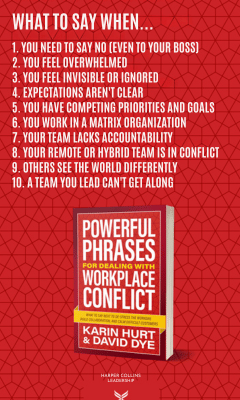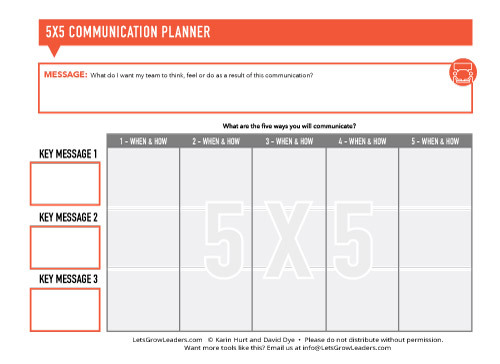David Dye's Blog, page 10
February 21, 2025
How to Thrive When Your Boss is Disengaged
You’re giving it your all. You’re solving problems, driving results, making things happen. But your boss? They’re off in another world. It could be your boss is disengaged. Or, maybe they are super engaged, just not on your MITs (most important things).
Maybe they’re laser-focused on a massive restructuring. Or, they’re drowning in budget meetings. It could be they’re obsessed with their passion project (which, unfortunately, has nothing to do with yours).
Meanwhile, you’re left thinking: Hello? Do you even know what I do around here?
I get it. I’ve been there. And while it’s frustrating to feel overlooked, you have more control than you think. Your work matters—even if your boss isn’t paying attention yet. The trick? Helping them see it.
Let’s talk about how.

Your boss is busy. But what exactly are they busy thinking about? What’s running through their mind when they stare at the ceiling at 2 AM?
Budget woes? They’re mentally tallying how much money they need to save before the next quarterly review.Performance pressure? They’re wondering how to keep their boss happy and avoid getting grilled in the next exec meeting.Big, scary change? They’re strategizing how to roll out a major company shift without sparking a mutiny.Office coffee drama? Okay, maybe not—unless caffeine supply issues are threatening workplace morale.The key is aligning your work with their worries. If you can position what you do as a solution to their biggest stressors, you’ll go from “nice-to-have” to “critical asset.”
See Also: The Manager Squeeze: How the New Workplace is Testing Team Leaders
Step 2: Help Them See Your Genius (Without a Neon Sign)Your work is valuable. But if your boss isn’t naturally tuned in, you’ll need to showcase it—without sounding like you’re bragging. Here’s how:
If they don’t define “great work,” you might be aiming at a moving target. Get clarity now, so that when the time comes for performance reviews, you know you’re aligned.
🔹 Define What Success Looks Like TogetherIf they don’t define “great work,” you might be aiming at a moving target. Get clarity now, so that when the time comes for performance reviews, you know you’re aligned.
👉 Try this:
“What would an extraordinary year look like for my role?”
This makes them reflect on your work and gives you insight into what’s at the top of their minds.
🔹 Give Them the Soundbite, Not the SagaA disengaged boss doesn’t have time (or patience) to sift through long-winded reports. When you update them, be crisp, clear, and results-focused.
👉 Try this:
“I’ve been working on [insert key project], and I know how important this is to [company priority]. Can we use 10 minutes in an upcoming staff meeting so I can update the team?”
More here: Managing Up: Turning Information into Influence with Your Boss
🔹 Make It Easy for Your Disengaged Boss to Brag About YouSometimes, your boss does appreciate your work—they just don’t think to mention it. So, help them out. Give them something they can easily repeat in meetings with their higher-ups.
👉 Try this:
“What do you see as the top three strengths I bring to the team? How do you think I could use them to contribute more?”
Not only does this reinforce what you’re doing well, but it also gives them talking points to highlight your value.
Step 3: Find Your ChampionsIf your boss isn’t your biggest advocate right now, that doesn’t mean you’re stuck. Build relationships with mentors, sponsors, and peers who do see your value. When decision-makers hear about your impact from others, it carries even more weight.
👉 Try this:
“With all the remote work in the last few years, I suspect we’re missing opportunities to really know one another’s strengths. Can I organize time in an upcoming meeting for us to share how we contribute best to the team?”
This gets you in front of the right people while fostering team connection. Win-win.
See Also: Tips for Improving Your Relationship with Your Chily Boss
Take Back Your PowerYes, your boss should be paying more attention. But whether they do or not, you have the ability to get the support, recognition, and career growth you deserve. Keep showing up, advocating for your work, and building the right relationships.
And if you need more help? Chapter 23 of “Powerful Phrases for Dealing with Workplace Conflict” is packed with even more ways to get noticed and respected—without the drama.
Now, over to you—how have you handled a disengaged boss? Drop your thoughts in the comments!
The post How to Thrive When Your Boss is Disengaged appeared first on Let's Grow Leaders.
Leading Gen Z With Less Conflict, More Productivity, and Better Morale
Episode 291: Are You Struggling to Lead and Retain Gen Z Employees?
Gen Z isn’t lazy—they just want work to fit into their lives, not the other way around. But for many leaders, this mindset shift creates tension, leading to high turnover and frustration on both sides. How can you bridge the gap and turn Gen Z into one of your biggest workplace assets instead of a management challenge?
In this episode, you’ll discover:
Why Gen Z values work-life balance differently—and how that benefits your team.The simple mindset shifts that make coaching and retaining Gen Z easier.Five essential questions to ask your Gen Z employees to foster trust and productivity.Don’t risk losing your best young talent—tune in now and start leading Gen Z with confidence!
Understanding Gen Z’s Mindset and Motivation[00:00] – Gen Z Wants Work to Fit Into Their Lives, Not the Other Way Around
Gen Z isn’t lazy—they prioritize work-life balance differently. Learn how life experiences like the pandemic shape their expectations.
[06:08] – Why More Gen Z Employees Are Leaving Jobs Quickly
Many leaders struggle to retain Gen Z workers. Find out what’s behind the turnover and how you can prevent it in your organization.
[08:54] – The Key to Navigating Tension Between Generations
Older generations often see Gen Z’s mindset as entitlement, but is it? This section explores shifting your perspective and creating a more productive workplace.
[17:04] – The Competitive Advantage of Hiring Gen Z Employees
Beyond their unique challenges, Gen Z employees bring incredible strengths. Learn what they excel at and how to leverage their skills for business success.
[23:06] – “Why Do I Need to Be on Time?” – How to Handle This Common Gen Z Question
Many leaders are frustrated with Gen Z’s different approach to punctuality. This section breaks down how to effectively set and communicate expectations.
[27:54] – 5 Key Questions to Build Stronger Relationships with Gen Z Employees
From preferred feedback styles to pet peeves, these five questions will transform how you lead and communicate with Gen Z team members.
[31:16] – How to Give Feedback to Gen Z Without Resistance
Gen Z values transparency and authenticity—but that doesn’t mean they’ll take criticism easily. Here’s how to deliver feedback in a way that resonates.
[36:33] – Recognition That Matters to Gen Z
Forget generic employee appreciation. Discover what motivates Gen Z workers and how to make recognition meaningful.
[39:14] – The Professional Development Strategy That Keeps Gen Z Engaged
Gen Z wants to grow, but their approach is different from that of past generations. Learn how to support their development in a way that keeps them invested.
[41:48] – The #1 Leadership Skill for Managing Gen Z Successfully
The key to leading Gen Z well isn’t about micromanaging or forcing them to conform—it’s about coaching them through self-awareness and trade-offs.
The post Leading Gen Z With Less Conflict, More Productivity, and Better Morale appeared first on Let's Grow Leaders.
February 14, 2025
Better Feedback: The Secret to Giving (and Getting) Better Feedback
You care about your team, and you want to help. But what do you do if your feedback doesn’t get through. How do you know if it’s them or it’s you? In today’s Asking for a Friend, I answer this frequently asked question, with tips on giving (and getting) better feedback.
Whales have a pretty cool way of navigating their world. They use echolocation—sending out sound waves, listening to the echoes, and adjusting based on what they hear. But here’s the key: they don’t do it alone. They move in pods, supporting and protecting each other. They get better feedback because communication is a team sport.
That’s exactly what great leaders do.
Practical Tips to Give Better Feedback

If you want to level up your human-centered leadership game, you need two things:
The ability to give and receive feedback like a pro.A solid “pod”—a group of trusted peers who challenge and encourage you as you grow.Let’s break it down.
1. Send Clear SignalsWhales don’t give vague, diaper-genie feedback. And neither should you. If you’re giving feedback, make it clear and specific. No vague “Good job” or confusing “Maybe next time you could… you know… think about… something different?” Nope.
Instead of: “Great report.”
Try: “Your report had awesome insights! Next time, adding a few graphs would help leadership grasp key points even faster.”
Instead of: “That didn’t go well.”
Try: “Hey, I noticed the client was frustrated. What if we try opening the conversation with solutions next time?”
See Also: Beyond Magical Thinking- How to Ensure Your Team “Gets It”
Note: If you’re thinking, “what the heck is diaper genie feedback? You’ll probably enjoy my (then) ten-year-old son, imitating my diaper genie bit on why clear communication matters when giving feedback.
2. Listen for the EchoFeedback is a two-way street. After you share, listen. The goal isn’t just to talk—it’s to understand.
Ask questions like:
“How did that land with you?”“What would make this easier to implement?”“Is there anything I can do to support you?”This is a deep check for understanding. What did they hear? How are they feeling? What are they going to do next?
3. Adjust Course as NeededWhales don’t just keep swimming straight if an obstacle pops up. They adjust. If someone reacts negatively or seems confused by your feedback, don’t just assume they got it. Reframe it.
“I can see this wasn’t what you expected. Let’s talk about what would work better for you.”
This shows you’re not just there to critique—you’re there to collaborate.
4. Create a Culture of Continuous FeedbackEcholocation isn’t a one-time thing. Neither is feedback. The best teams talk about what’s working (and what’s not) all the time—not just in yearly reviews.
Ways to make feedback a normal thing:
Quick check-ins after projectsFeedback huddles (yes, like a sports team!)An open-door policy for real talk5. Find Your Pod (and Use It Wisely)Whales don’t swim solo. The best leaders don’t either. You need a pod—a group of peers who challenge, support, and push you to grow.
Why? Because:
Safe Space to Practice – You can try different feedback styles without the pressure.Balanced Growth – Too much challenge? Burnout. Too much support? Stagnation. A pod gives you both.Accountability – When you say you’ll work on something, your pod keeps you honest.How to build your pod:
Set up regular check-ins (virtual coffee dates count!).Practice hard conversations with each other.Make a pact to be real—no sugarcoating, just honesty and support.We do this in our certificate in human-centered leadership programs through challenge and support groups. Think executive-led mentoring circles focused on immediate application to ensure your leadership training sticks.
6. Psychological Safety: The Secret SauceIf you want people to be honest with you, they need to feel safe. That means no defensiveness when someone gives you feedback. Instead, try:
“That’s a great point—how do you think we should handle it next time?” “I appreciate you bringing this up. Let’s figure out a way forward together.”
“I appreciate you bringing this up. Let’s figure out a way forward together.”That’s how trust is built.
Powerful Phrases for Better FeedbackNeed some go-to lines? Here are a few:
To invite feedback: “I’d love to hear your take—what’s one aspect of my leadership that’s working well, and what could be better?”To mix praise and growth: “One thing I appreciate about your work is ___. One area for growth is ___.”To open a dialogue: “Tell me more about how you approached this. I want to understand your thinking.”Final Thought: Swim Like a Whale, Lead Like a BossWhales thrive because they:
Communicate clearly.Listen deeply and adjust.Stick with their pod.You can do the same.
So—who’s in your pod? And what’s one best practice you use to give (or receive) better feedback?
Are you looking to bring practical, human-centered leadership tools to your organization, we’d love to help. Drop us a note at info@letsgrowleaders.com.
The post Better Feedback: The Secret to Giving (and Getting) Better Feedback appeared first on Let's Grow Leaders.
Echo Effect: The Secret to Giving (and Getting) Better Feedback
Whales have a pretty cool way of navigating their world. They use echolocation—sending out sound waves, listening to the echoes, and adjusting based on what they hear. But here’s the key: they don’t do it alone. They move in pods, supporting and protecting each other. They get better feedback because communication is a team sport.
That’s exactly what great leaders do.
Practical Tips to Give Better Feedback

If you want to level up your human-centered leadership game, you need two things:
The ability to give and receive feedback like a pro.A solid “pod”—a group of trusted peers who challenge and encourage you as you grow.Let’s break it down.
1. Send Clear SignalsWhales don’t give vague, diaper-genie feedback. And neither should you. If you’re giving feedback, make it clear and specific. No vague “Good job” or confusing “Maybe next time you could… you know… think about… something different?” Nope.
Instead of: “Great report.”
Try: “Your report had awesome insights! Next time, adding a few graphs would help leadership grasp key points even faster.”
Instead of: “That didn’t go well.”
Try: “Hey, I noticed the client was frustrated. What if we try opening the conversation with solutions next time?”
See Also: Beyond Magical Thinking- How to Ensure Your Team “Gets It”
Note: If you’re thinking, “what the heck is diaper genie feedback? You’ll probably enjoy my (then) ten-year-old son, imitating my diaper genie bit on why clear communication matters when giving feedback.
2. Listen for the EchoFeedback is a two-way street. After you share, listen. The goal isn’t just to talk—it’s to understand.
Ask questions like:
“How did that land with you?”“What would make this easier to implement?”“Is there anything I can do to support you?”This is a deep check for understanding. What did they hear? How are they feeling? What are they going to do next?
3. Adjust Course as NeededWhales don’t just keep swimming straight if an obstacle pops up. They adjust. If someone reacts negatively or seems confused by your feedback, don’t just assume they got it. Reframe it.
“I can see this wasn’t what you expected. Let’s talk about what would work better for you.”
This shows you’re not just there to critique—you’re there to collaborate.
4. Create a Culture of Continuous FeedbackEcholocation isn’t a one-time thing. Neither is feedback. The best teams talk about what’s working (and what’s not) all the time—not just in yearly reviews.
Ways to make feedback a normal thing:
Quick check-ins after projectsFeedback huddles (yes, like a sports team!)An open-door policy for real talk5. Find Your Pod (and Use It Wisely)Whales don’t swim solo. The best leaders don’t either. You need a pod—a group of peers who challenge, support, and push you to grow.
Why? Because:
Safe Space to Practice – You can try different feedback styles without the pressure.Balanced Growth – Too much challenge? Burnout. Too much support? Stagnation. A pod gives you both.Accountability – When you say you’ll work on something, your pod keeps you honest.How to build your pod:
Set up regular check-ins (virtual coffee dates count!).Practice hard conversations with each other.Make a pact to be real—no sugarcoating, just honesty and support.We do this in our certificate in human-centered leadership programs through challenge and support groups. Think executive-led mentoring circles focused on immediate application to ensure your leadership training sticks.
6. Psychological Safety: The Secret SauceIf you want people to be honest with you, they need to feel safe. That means no defensiveness when someone gives you feedback. Instead, try:
“That’s a great point—how do you think we should handle it next time?” “I appreciate you bringing this up. Let’s figure out a way forward together.”
“I appreciate you bringing this up. Let’s figure out a way forward together.”That’s how trust is built.
Powerful Phrases for Better FeedbackNeed some go-to lines? Here are a few:
To invite feedback: “I’d love to hear your take—what’s one aspect of my leadership that’s working well, and what could be better?”To mix praise and growth: “One thing I appreciate about your work is ___. One area for growth is ___.”To open a dialogue: “Tell me more about how you approached this. I want to understand your thinking.”Final Thought: Swim Like a Whale, Lead Like a BossWhales thrive because they:
Communicate clearly.Listen deeply and adjust.Stick with their pod.You can do the same.
So—who’s in your pod? And what’s one best practice you use to give (or receive) better feedback?
The post Echo Effect: The Secret to Giving (and Getting) Better Feedback appeared first on Let's Grow Leaders.
Reduce Stress And Have More Influence With The Power of Improv
Episode 290: What if the secret to reducing stress at work wasn’t in planning more but in responding better?
Unexpected changes and challenges are inevitable in leadership. How you respond to them can either add to your stress or unlock new levels of creativity, influence, and problem-solving. This episode reveals how the principles of improv can help you embrace uncertainty and lead with confidence.
Learn how to shift from resistance to adaptability using the power of “Yes, and.”
Discover practical techniques to build better workplace relationships and increase your influence.
Gain strategies to make faster, more effective decisions—without feeling out of control.
Listen now to discover how a simple mindset shift can help you reduce stress, make better decisions, and lead with confidence!
Mastering “Yes, And” for Leadership Success[03:14] – A Leadership Lesson from High School Theater
Avi shares his earliest leadership experience directing a play in his community, revealing how early mistakes—like being too controlling—taught him valuable lessons about influence and adaptability.
[05:38] – How Resistance Creates Stress and Kills Innovation
Leaders often encounter resistance from employees and within themselves. Avi explains how the phrase “Yes, but” creates barriers, while “Yes, and” opens the door to adaptability and better problem-solving.
[10:06] – The Key to Handling Unexpected Challenges Without Panic
Improv teaches us that we can’t control everything—only our response to what happens. Avi shares a practical approach to staying calm and confident when faced with change.
[14:37] – How Leaders Can Encourage Innovation Without Losing Control
Worried about letting go of control? Learn how to use “Yes, and” to engage your team in problem-solving, explore their ideas without committing too soon, and foster a culture of creativity.
[18:57] – The Surprising Power of Asking the Right Questions
When an employee proposes an idea that doesn’t align with priorities, don’t shut it down. Instead, ask: “How do you see this fitting into our goals?” This simple shift can unlock deeper thinking and better alignment.
[25:54] – Saying “Yes, And” to Yourself Instead of “Yes, But”
Your inner dialogue has a huge impact on your stress levels and success. Avi explains how recognizing your persistent “Yes, but” thoughts and shifting them to “Yes, and” can lead to growth and new opportunities.
[29:45] – Finding Your Own Process for Success
Productivity advice isn’t one-size-fits-all. Discover why understanding your personal strengths and working style is key to reducing stress and achieving your goals without frustration.
[34:40] – How to Say No Without Feeling Guilty
Saying “No, but” instead of “Yes, but” is a game-changer. Learn how to set boundaries, prioritize effectively, and say no in a way that maintains relationships and respect.
[38:54] – Leading Up: Handling a Manager Who Won’t Make Decisions
When a boss is stuck in analysis paralysis, it can create stress for everyone. Avi shares how to approach this situation with a “Yes, and” mindset to keep projects moving forward.
[41:30] – The First Step to Practicing “Yes, And” in Your Leadership
Not sure where to start? Avi’s simple, actionable tip will help you identify your “Yes, but” moments and begin applying “Yes, and” thinking to reduce stress and improve your leadership approach.
The post Reduce Stress And Have More Influence With The Power of Improv appeared first on Let's Grow Leaders.
February 13, 2025
Recognition Power Words: The Phrases that Mean the Most
Think about the best recognition you’ve ever received. Who said what, and why did it hit you so deeply?
Recently, two people told me, “I am proud of you.” Both times, my throat tightened with unexpected emotion. Their words lingered because they weren’t just compliments—they were reflections of respect, care, and sincerity. That got me thinking: What made this recognition so powerful? More importantly, what can I learn from that experience to help you (and me) provide more meaningful recognition through powerful words?
Why Meaningful Recognition SticksIt’s not just about what you say—it’s who says it, why they say it, and how it connects to what matters most to the person receiving it.
1. The Messenger MattersPraise from someone you respect or admire carries extra weight. It’s a reminder that your contributions don’t just matter—they’re seen and valued by someone you hold in high regard.
2. The Achievement MattersThe most meaningful recognition highlights accomplishments that matter to you. It’s not about flattery; it’s about feeling that someone understands what you worked hard for and why it’s important.
3. The Words MatterPowerful words are simple, specific, and sincere. Generic praise fades fast. But words that connect to effort, impact, or growth leave a lasting impression.
Think about the best recognition you’ve ever received. Who said what, and why did it hit you so deeply?
See Also: How to Make Better Frequent Employee Recognition a Daily Habit
How to Ensure Your Team Gets the Recognition They Deserve (Video)
Using the 4 Cs of Collaboration to Make Your Words CountMeaningful recognition happens when it builds Connection, fosters Clarity, shows genuine Curiosity, and leads to a Commitment to celebrate each other’s contributions. Here’s how to use the 4 Cs to give recognition that sticks:
CONNECTION – Recognize the Person, Not Just the WorkRecognition lands best when it feels personal and human-centered. It’s not just about the task completed—it’s about who they are and how they show up.
Powerful Phrases to Build Connection:
“I care about you and what you’ve accomplished here.”“You are such a vital part of this team because…”“I admire how you handled…”“You consistently show up with heart and integrity.”“I see you, and I see how much you care.”CLARITY – Be Specific About What Mattered MostVague praise (“Good job!”) fades quickly. Specificity shows you’ve truly noticed their effort. Recognize not only what they did, but why it mattered.
Powerful Phrases to Create Clarity:
“The way you [specific action] made a real difference because…”“You’ve raised the bar with [specific result].”“What you did with [project/situation] set a new standard for excellence.”“I trust you because you consistently…”“Because of you, we were able to…”CURIOSITY – Tailor Your Recognition to Their StyleEveryone receives appreciation differently. Show you care by learning how they prefer to be recognized. Some people love public praise, while others prefer a private acknowledgment.
Powerful Phrases to Cultivate Curiosity:
“I want to celebrate you—how do you prefer to be recognized?”“What part of your work are you most proud of?”“What motivates you most when you receive feedback?”“Can you tell me about a time when recognition really mattered to you?”“How can I best support and acknowledge your contributions?”COMMITMENT – Make Recognition a Habit, Not an AfterthoughtThe best cultures celebrate regularly, not just during performance reviews. Make it a shared commitment to acknowledge and celebrate wins together.
Powerful Phrases to Show Commitment:
“Let’s make it a habit to celebrate progress as well as results.”“I commit to sharing what I see and appreciate about your work regularly.”“Let’s recognize someone from the team at each meeting.” “I’d love to capture this win and share it with others—are you okay with that?”“Our team wouldn’t be the same without your contributions, and I’ll make sure others know it too.”🗨️ Recognition Power Phrases by Personality Type
“I’d love to capture this win and share it with others—are you okay with that?”“Our team wouldn’t be the same without your contributions, and I’ll make sure others know it too.”🗨️ Recognition Power Phrases by Personality TypeInspiring Personalities (e.g., salespeople):
“That was awesome!” | “You crushed it!” | “I owe you one for that!”
Commanding Personalities (e.g., directors):
“That’s why you’re the best.” | “You nailed it.” | “You’re a force to be reckoned with.”
Supporting Personalities:
“Everyone loved what you did.” | “You’ve made a difference for so many people.” | “You bring such heart to your work.”
Analytical Personalities:
“Your approach was brilliant.” | “I’d love to know how you came up with that solution.” | “You’ve set a new standard of excellence.”
Note this article was originally published in 2012, as one of my first blog posts. It continues to be so popular, you deserved an upgrade so I updated it recently (but kept the amazing comments for you to read and contribute and keep the conversation going).
if you’re interested in workplace communication and powerful phrases you might enjoy our new book, Powerful Phrases for Dealing with Workplace Conflict: What to Say Next to De-Stress the Workday, Build Collaboration and Calm Difficult Customers. You can download free chapters here, or visit our resource center that has a free Conflic and Collaboration Resource Guide to make it easy for teams to read and discuss Powerful Phrases together.
The post Recognition Power Words: The Phrases that Mean the Most appeared first on Let's Grow Leaders.
February 10, 2025
Not My Tornado: How to Stop Workplace Distractions from Stealing Your Focus
Ever feel like your workday is a full-blown tornado of workplace distractions—emails flying in, urgent requests swirling around, and meetings popping up like unexpected hail?
Just when you think you’ve got a handle on things, another task comes spinning your way.
Distractions at work are everywhere, and if you don’t take control, you’ll spend your day chasing debris instead of making real progress. The key is learning to step out of the storm, focus on what matters, and help your team do the same. Let’s break down the biggest distraction traps—and how to escape them.
We All Have Our Favorite Workplace Distractions– How to Overcome YoursFirst, a confession. We don’t have this handled. Sometimes we write as much for us as for you.
We both take on A LOT (often too much). Often it seems the only way through the storm is to work harder, longer, or faster.
We work long hours and try to dig out on weekends. As we write this, we are in desperate need of a vacation.
I (Karin) am an “in-box addict.” Being responsive to our clients and prospects is a core value for me. Plus, when a speaking bureau is looking for a keynote speaker, it’s a known industry truth that responding within the first few hours increases your chance of getting the gig.
And with that said, all the advice in this article still applies. I DON’T need to check emails every ten minutes to be responsive. And neither do you.
So, here we go. Here are a few practical tips to de-stress your day and productivity for us AND for you.

Pew Got ’em. You’re always riding shotgun to overwhelm.
Flying through the day, tackling everything that hits your dashboard the second it appears. Someone needs a report? Done. Last-minute request? No problem. The problem? You’re always reacting and never really getting ahead.
Your brain gets addicted to the adrenaline rush of urgent tasks and workplace distractions. The busier you are, the more productive you feel—but at the end of the day, your most important work? Still sitting there, untouched.
How to Get Your Focus Back:Pause before jumping into a new task—ask yourself, “Is this important, or just loud?”Set time blocks for deep work where you don’t check email or messages (yes, they will survive).Learn to say, “I’ll get to this after I finish my current priority.”
Your new mantra:
“Not every gust of wind needs my attention.”
See Also: How to Stay Focused at Work (And Avoid the Dreaded Rabbit Hole) A Karin Hurt “Asking for a Friend” Video.
2. Work Harders – “I’ll Just Work More” PeopleYou believe the solution to too much work is… more work. Sleep is optional. Lunch is for the weak. Weekends? Overrated. You make up for workplace distractions on your own time.
Sure, your dedication is impressive, but let’s be real—you’re running on fumes. And over time, exhaustion leads to mistakes, slower thinking, and general crankiness (which no one enjoys).
How to Get Your Focus Back:Work smarter, not longer—are there tasks you can delegate, automate, or (gasp!) just not do?Take breaks. Seriously. Science says your brain works better when you rest.Set actual work boundaries—your inbox will still be there in the morning.
Your new mantra:
“Find the calm in the eye of the storm.”
Your motto? “Who do I need to keep happy today?” Your priorities are dictated by whoever is the loudest, the most stressed, or the most important-looking in a meeting.
You hate conflict, so you agree to things before even thinking about whether they make sense for your workload. The problem? By trying to keep everyone happy, you’re actually making yourself miserable.
Note
: if you hate conflict, we can help! Check out our Workplace Conflict and Collaboration Resource Center.
Your new mantra:
“Not my tornado, not my cows.”
 You treat your inbox like a to-do list, jumping on every email, Slack, or IM the moment it arrives. New message? Must be important! Someone added you to a random thread? Better chime in!
You treat your inbox like a to-do list, jumping on every email, Slack, or IM the moment it arrives. New message? Must be important! Someone added you to a random thread? Better chime in!
Before you know it, half your day is gone, and your real work hasn’t even started.
How to Get Your Focus Back:Turn off notifications (yes, you can do this, and yes, the world will still function).Check email at set times instead of living in your inbox. Create a system to separate urgent from non-urgent (Hint: not everything is urgent).
Your new mantra:
“Not every email is a category five emergency.”
Distractions aren’t going away anytime soon, but you can get better at managing them. The key is recognizing your distraction style and making small, intentional changes.
So, which workplace distraction traps do you fall into? And more importantly, what’s one thing you can do today to break free?
We have lots of ways we help teams focus on what matters most from our human-centered leadership programs to our SynergySprint Team Retreats, and highly interactive keynotes. We would love to set up an exploratory conversation and learn more about you and your goals for growing leaders.
The post Not My Tornado: How to Stop Workplace Distractions from Stealing Your Focus appeared first on Let's Grow Leaders.
February 7, 2025
How to Build Culture That Unites Inspires And Gets Results
Episode 289: How can you build a culture that unites your team, inspires action, and drives real results?
In this Leadership Without Losing Your Soul episode, host David Dye speaks with culture expert Laura Hamill, an organizational psychologist and author of The Power of Culture. They discuss why culture is not just about values on a wall but about shaping everyday behaviors, decisions, and team dynamics. Whether you’re leading a small team or an entire organization, your culture exists—so how can you shape it to work for you rather than against you?
By tuning in, you’ll discover:
Why culture exists whether you define it or not—and how to take control of it.The “Intentional Culture Circle” framework for building and sustaining a culture that aligns with your business goals.How to balance hearts and minds at work—bringing emotion into leadership to foster connection, belonging, and engagement.If you’re ready to build a culture that unites, inspires, and fuels performance, hit play now and start transforming the way your team works together!
Defining Culture and Why It Matters[05:22] – What is culture, really? Laura Hamill explains how culture is more than just words—it’s the everyday behaviors, decisions, and mindsets that shape an organization’s success.
[07:47] – You already have a culture—so is it working for or against you? David and Laura discuss how culture exists whether leaders define it or not and why neglecting it can lead to unintended consequences.
[16:45] – The #1 reason culture goes wrong. Leaders often treat culture as a side project or an HR initiative rather than a core business driver, which causes misalignment and disengagement.
[19:33] – Accountability and culture: why they go hand in hand. If leaders don’t model and enforce cultural expectations, employees will disengage from the values and create their own norms instead.
[24:02] – How to build culture by embedding it in everyday work. Culture isn’t just a workshop or an annual event—it must be intentionally integrated into hiring, strategy, performance management, and leadership behaviors.
Practical Strategies to Build Culture and Strengthen Teams[26:10] – Beyond buzzwords: making values real. Many organizations define values but fail to clarify what they look like in action. Laura shares how to translate values into daily behaviors.
[33:04] – Try this simple exercise to assess your team’s real culture. Ask employees to list five words that describe the current culture—then compare those to the company’s stated values. The differences might surprise you!
[37:31] – Building a culture oasis in a tough environment. Even if the broader organization struggles with culture, leaders can create a thriving, engaged team by focusing on how they interact and support one another.
[42:14] – The power of hearts and minds in leadership. Culture isn’t just logic and process—it’s about creating emotional connections, fostering belonging, and inspiring people to do their best work.
[43:56] – Why leaders must embrace emotion at work. The old-school approach of “leaving emotions at the door” doesn’t work anymore. Recognizing and valuing emotions helps build a culture that supports both engagement and performance.
The post How to Build Culture That Unites Inspires And Gets Results appeared first on Let's Grow Leaders.
February 3, 2025
5×5 Communication: a Leadership Communication Strategy to Ensure Your Message Sticks
You’ve said it. You’ve said it again. And yet, somehow, people still don’t seem to know what’s going on. If you’re ever frustrated that your team doesn’t act on important priorities, you’re not alone. Leaders everywhere wrestle with getting their message to stick. That’s where your 5×5 Communication Strategy comes in.
5×5 communication means that you communicate your most important messages five times, in five different ways. A 5×5 communication strategy ensures your team and organization internalize those critical messages.
When No One Seems to Get ItToo often, leaders assume that because they said something once, people heard it, understood it, and will act on it. But people are busy. They’re flooded with information, juggling priorities, fighting fires, and moving fast. What you said in last week’s meeting might have been clear in the moment, but say it only once and that message quickly fades into the background.
And if your people haven’t internalized critical messages, that means you have work to do in how—and what—you communicate.
Why 5×5 Communication WorksWhen we first explain 5×5 communication to new managers, sometimes they reply, “Do I really need to say something five times? Isn’t that excessive?”
The short answer is no, it’s not. And for the most critical messages, five times is just a beginning.
The reason begins with how people build memories and retain information. It’s no exaggeration to say that every time you form a memory, your brain changes. You literally build new connections (or strengthen existing connections) between neurons.
Four Ways to Build MemoryAs a leader focused on building an effective communication strategy, four of the most important memory-building principles for you are recency, repetition, recall, and emotion.
RecencyOne way to spark memory is through recent experience. You probably remember what you had for breakfast today … but lunch three weeks ago is likely fuzzier.
RepetitionIt’s easier to remember what you encounter more often. Hear a song once and you might say “that’s a nice song.” Hear that song ten times and it might not leave your mind for a week–whether or not you want it to.
RecallOne way we strengthen memories and retain information is by accessing it. When you have to recall the information to answer a question or do your work, you are more likely to retain it. (An addition benefit of checking for understanding.)
EmotionEmotion has a powerful effect on memory. If you reflect back on a time you experienced a strong emotion, you probably remember more about your surroundings. For example, I (David) have been in many high school auditoriums, but I still remember details of the auditorium where I learned I’d won my first multi-state high school debate tournament.
Effective leaders don’t leave these memory enhancers to chance. You can build processes and plan your remote team communication strategies to leverage these characteristics of memory.
How a 5×5 Communication Strategy Builds MemoriesSaying something once, in one way, isn’t enough. People process information differently, and they need repetition to absorb it. That’s why five different channels matter.
Communicating a key message five different times taps into recency and repetition. When you use five different channels, or ways of communicating, you can leverage recall and emotion to help people build memories.
Here’s a sample 5×5 communication strategy and how each step helps team members internalize the message:
Monthly Team Meeting—first communication, includes a powerful “why” and how the change fits into existing work and makes it easier.[This is the first Repetition and includes some Emotion since it makes work easier.]
Weekly One-on-One—second communication. The manager asks the team member to describe the change in their own words and ask any questions they have.[This is the second Repetition, increases Recency, and includes Recall]
Video Update—third communication. Two weeks after the initial meeting, the manager sends the team a quick phone-video message through their IM channel, celebrating progress and early wins.[This is the third communication. It leverages Repetition, Recency, and Emotion.]
Team Sharing—fourth communication. The manager invites team members to share how they implemented the new process and solved key problems.[This is the fourth communication. It leverages Repetition, Recency, Recall, and Emotion.]
Town Hall Celebration—fifth communication. The manager surprises the team during an all-hands meeting by celebrating their effort and having the CEO congratulate the team for their achievement with the new process.[This is the fifth communication. It leverages Repetition, Recency, and Emotion]
You can use the 5×5 Communication Planner to build your communication strategy:

For your 5×5 communication to stick and change behavior, you need to communicate consistently, clearly, and in a way that helps your team answer three questions:
Why the message matters?How the message fits in with existing work and strategies?What to do next?1. Communicate the “Why”—Context is EverythingBefore you even think about the logistics of a project or task, people need to understand why it matters.
How does this fit into the bigger picture?Why should they care?What problem does it solve?It’s easy to jump straight to “Here’s what we need to do,” but without context, your team is just checking boxes. To create those “aha” moments and build connection, start with the why.
Let’s say you’re launching a new customer service initiative. Instead of saying, “We need to respond to customer inquiries faster,” explain:
“We’re losing customers because they aren’t getting the timely support they need. Our new service goal isn’t just about speed—it’s about building trust and keeping our customers coming back.”
By starting with why, you give people a reason to care. And when people care, they act with more urgency and ownership.
2. Connect to Existing Work—Avoid the “One More Thing” SyndromeOne of the biggest reasons initiatives fail is that they feel like extra work rather than integrated priorities.
Your team is already busy. If they see your message as just another task on top of everything else, it slips to the end of the list.
Instead, connect the dots between what you’re asking and what they’re already doing.
For example, instead of saying, “We need to improve collaboration between teams,” try:
“You’re already doing great work solving customer issues. If we tighten communication with the sales team, we can resolve problems even faster and make your job easier.”
When people see how a change fits into their existing workflow (rather than disrupting it), they’re far more likely to understand and internalize the change.
3. Address What’s Next—Answer ‘How do I act on this?’Even the most motivated people need to understand how an initiative affects them personally. They may see the benefit in a general sense, but what does the change require of them? How do they implement or support it in their work?
To make your message stick, tailor it to different audiences.
For example, if you’re rolling out a new project management tool, instead of telling everyone generally, “We’re switching systems next month,” say:
Right now, I know you’re spending too much time chasing updates. With this tool, you’ll have everything in one place, so you can focus on the work that really matters.
If you’re a manager, you’ll need to schedule 90 minutes of training for your team and create two hours of white space for each team member next month.
For team members, plan on those 90 minutes of training, and then use that two hours to run them side-by-side so you can get used to the new system and make sure we answer all your questions.
When people know specifically what they should do, they’re far more likely to embrace it.
Don’t Stop with 5×5After you implement your 5×5 communication strategy, you can continue to support, reinforce, and enhance your communication by:
Modeling the behavior—If you’re asking for faster decision-making, show that you’re making decisions quickly, too.Checking in regularly—Ask, “How’s it going?” “What’s getting in your way?” “What’s working well?”Celebrating progress—Recognize early adopters and share success stories to keep momentum going.When people see consistent reinforcement, they know it’s not just another “flavor of the month” initiative—this matters.
Make a 5×5 Communication Strategy Work for YouUsing 5×5 Communication doesn’t mean you need to micromanage or overwhelm your team with endless reminders. It’s about being intentional and strategic in how you share your message.
So next time you need people to take action, ask yourself:
Have I clearly communicated why this matters?Have I shared the message in five different ways?Have I connected it to their existing work?Have I made the next steps clear?Am I reinforcing and following up consistently?When you communicate this way, your team won’t just hear your message—they’ll act on it.
And that’s how genuine change happens.
Your Turn: What’s One Message You Need to Reinforce Right Now?Think about an initiative, priority, or project that hasn’t gained traction. How can you use 5×5 Communication to make it stick?
Drop a comment below—we’d love to hear how you’re putting it into action!
For More Critical Leadership Communication Strategies:
Workplace Communication: Stop Asking “Do You Understand?” (and do this instead)High ROI Leadership: Schedule the FinishA Leadership Communication Strategy to Ensure Your Team Knows Where to Focus (a 5×5 communication podcast episode)101 Ways to Communicate with Your Remote TeamThe post 5×5 Communication: a Leadership Communication Strategy to Ensure Your Message Sticks appeared first on Let's Grow Leaders.
January 31, 2025
A Leadership Communication Strategy to Ensure Your Team Knows Where to Focus
How can you ensure your leadership communication strategy cuts through the noise and actually sticks with your team?
In today’s workplace, competing priorities and constant digital distractions make it easy for key messages to get lost. Without a clear communication strategy, your team may struggle to stay focused on what truly matters. This episode reveals how to make your messages memorable and actionable.
What You’ll Learn in This Episode:
The brain science behind how people retain and internalize key messages.How the Five by Five Communication Method ensures clarity and focus.Creative ways to reinforce messages so they become second nature to your team.Hit play now to master a strategy that keeps your team aligned, engaged, and focused on success.
Mastering Leadership Communication: The Five by Five Strategy[00:00] – Why Your Messages Get Lost
With competing priorities, digital distractions, and information overload, your communication might not be getting through. This episode introduces a leadership communication strategy to ensure your team internalizes what matters.
[02:16] – The Four Principles of Memory
For communication to be effective, it must align with how the brain builds and retains memories. Learn how recency, repetition, recall, and emotion play a crucial role in strengthening your leadership communication strategy.
[05:54] – The Five by Five Communication Method
One or two messages won’t cut it. Discover how reinforcing key messages five times in five different ways ensures your team understands and retains critical information.
[07:57] – The Power of Visual Reinforcement
Emails and meetings aren’t enough. Explore visual strategies like digital banners, whiteboards, and branded team gear to reinforce key messages effectively.
[09:47] – Adding Fun and Emotion to Communication
From gamification to creative competitions, tapping into emotion helps messages resonate. Even humor and surprise can improve retention.
[10:39] – Unconventional Messaging Techniques
Using tools like handwritten notes, text messages, and even food packaging can make messages more memorable. Leadership communication strategy works best when it’s engaging and unexpected.
[11:31] – Making Messages Unforgettable
If your team can recall a message in their sleep, you know it’s working. Learn how repetition and multiple formats ensure long-term retention.
[12:26] – The Importance of Context in Communication
Telling people what to do isn’t enough—they need to know why it matters and how it fits into the bigger picture. Providing context strengthens message retention and team alignment.
[13:12] – Helping Your Team Take Action
Once your message is clear, the next step is ensuring your team knows how to apply it in their daily work. This section breaks down the importance of providing specific actions and expectations.
[14:04] – Why Leadership Communication Strategy Matters
Using the Five by Five Method isn’t just about clarity—it reduces stress, boosts productivity, and keeps your team focused on what truly matters.
The post A Leadership Communication Strategy to Ensure Your Team Knows Where to Focus appeared first on Let's Grow Leaders.





